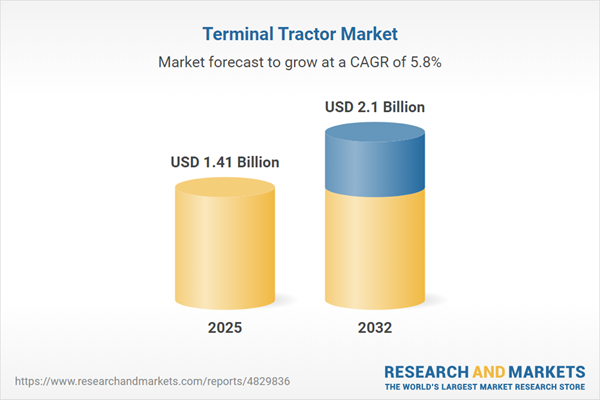Speak directly to the analyst to clarify any post sales queries you may have.
Terminal tractors play a pivotal role in shaping modern supply chain strategies, empowering senior decision-makers to address regulatory demands, advance operational efficiency, and support evolving sustainability goals within high-stakes logistics environments. Their integration is transforming how logistics networks adapt to technological change, risk, and growth opportunities.
Market Snapshot: Terminal Tractor Market Size and Growth Overview
The terminal tractor market is experiencing consistent global expansion, driven by increasing automation and the digital transformation of supply chain operations. In 2024, the sector holds a value of USD 1.34 billion and is forecasted to grow to USD 1.41 billion in 2025, reaching an estimated USD 2.10 billion by 2032. The projected compound annual growth rate (CAGR) stands at 5.78%. This upward trajectory is supported by stricter regulatory standards, significant modernization efforts, and accelerated adoption of digital and automated solutions across multiple industries. As market forces shift, executives are prompted to review procurement frameworks, modernize infrastructure, and develop strategic investments that match the pace of logistics innovation.
Scope & Segmentation of the Terminal Tractor Market
Thorough market segmentation offers senior leaders practical visibility for prioritizing investments and operational changes. A comprehensive understanding of the following segments helps businesses target solutions that align with compliance objectives and deliver measurable improvements in logistics workflows.
- Powertrain: Diesel, electrified units using lead-acid or lithium-ion batteries, LNG, and hybrid systems provide tailored options for emission control and sustainability mandates.
- Horsepower Range: Compact models are available for space-constrained sites, while high-capacity configurations address heavy-duty and high-throughput operational needs.
- Operation Mode: Manual and automated controls, featuring advanced vision and lidar technologies, empower users to enhance workforce efficiency and workflow productivity.
- Speed: Adjustable speed settings allow for customized balancing of throughput requirements with local safety and compliance standards.
- Application: Terminal tractors service a diverse array of environments, including airports, seaports, intermodal hubs, manufacturing areas, distribution centers, and warehouses.
- Geography: The market spans the Americas, Europe, Middle East and Africa, and Asia-Pacific, each shaped by distinctive infrastructure realities, compliance frameworks, and sourcing considerations that inform procurement strategies.
- Companies Analyzed: Key industry players such as Kalmar Corporation, BYD Company Limited, CVS Ferrari, FERNRIDE GmbH, Hoist Material Handling, Konecranes, Linde Material Handling, MAFI Transport-Systeme, Orange EV, Outrider Technologies, Saic-Iveco Hongyan, Sany Group, Terberg Group, TICO Tractors, and Volvo AG demonstrate varied supplier strengths and innovation profiles.
Key Takeaways for Senior Decision-Makers
- Terminal tractors enable organizations to remain agile, supporting fast adaptation to evolving logistics scenarios and operational demands.
- Shifting toward electrified and alternative-fuel technologies aligns enterprises with current and upcoming sustainability regulations, reducing long-term compliance risk.
- Integrating telematics and automation increases real-time fleet visibility, enhances predictive maintenance protocols, and helps maintain high workplace safety standards.
- Investing in automated solutions and robust safety features strengthens logistics networks’ ability to withstand regulatory and operational disruptions.
- Upgrading infrastructure with smart charging and advanced monitoring supports both scaling in new facilities and optimizing operations at established sites.
- Regional procurement strategies tailored to local regulatory changes and trade conditions lower cross-border sourcing vulnerabilities and support business continuity.
Tariff Impact on Terminal Tractor Sourcing
Recent updates to United States tariff policies are prompting businesses to diversify terminal tractor sourcing strategies, deepening domestic partnerships and reevaluating procurement models for greater flexibility. These responses help mitigate trade-related risks and maintain steady supply chains in a frequently shifting regulatory environment.
Methodology & Data Sources
This analysis is built upon in-depth interviews with manufacturing leaders, fleet managers, leasing professionals, and technical advisors. All data are corroborated against recognized industry research and recent regulatory documentation to ensure reliable support for executive decisions.
Why This Report Matters
- Enables timely, data-driven decision-making for infrastructure modernization and resource allocation.
- Equips cross-functional teams with detailed segmentation and technology insights for compliance-aligned process improvement.
- Supports executive leadership in responding to supply chain and regulatory changes at regional and global levels.
Conclusion
Terminal tractors have become indispensable tools for logistics leaders aiming to futureproof operations and sustain compliance. This report provides a structured foundation for driving strategic investments in an evolving supply chain landscape.
Additional Product Information:
- Purchase of this report includes 1 year online access with quarterly updates.
- This report can be updated on request. Please contact our Customer Experience team using the Ask a Question widget on our website.
Table of Contents
3. Executive Summary
4. Market Overview
7. Cumulative Impact of Artificial Intelligence 2025
Companies Mentioned
The companies profiled in this Terminal Tractor market report include:- Kalmar Corporation
- AUTOCAR, LLC
- BYD Company Limited
- Capacity Trucks
- CVS Ferrari
- Dongfeng Motor Corporation
- FERNRIDE GmbH
- Hoist Material Handling
- Hyster‑Yale Materials Handling
- Konecranes
- Linde Material Handling by KION Group
- MAFI Transport-Systeme
- MOL Trucks
- Orange EV
- Outrider Technologies
- REV Group
- Saic-Iveco Hongyan
- Sany Group
- Shacman
- Sinotruk
- Terberg Group
- TICO Tractors
- Volvo AG
Table Information
| Report Attribute | Details |
|---|---|
| No. of Pages | 180 |
| Published | October 2025 |
| Forecast Period | 2025 - 2032 |
| Estimated Market Value ( USD | $ 1.41 Billion |
| Forecasted Market Value ( USD | $ 2.1 Billion |
| Compound Annual Growth Rate | 5.7% |
| Regions Covered | Global |
| No. of Companies Mentioned | 24 |









